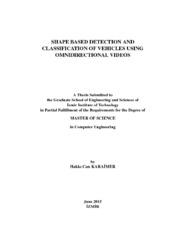Please use this identifier to cite or link to this item:
https://hdl.handle.net/11147/4320Full metadata record
| DC Field | Value | Language |
|---|---|---|
| dc.contributor.advisor | Baştanlar, Yalın | - |
| dc.contributor.author | Karaimer, Hakkı Can | - |
| dc.date.accessioned | 2015-08-11T07:44:59Z | |
| dc.date.available | 2015-08-11T07:44:59Z | |
| dc.date.issued | 2015-06 | - |
| dc.identifier.citation | Karaimer, Hakkı C. (2015). Shape based detection and classification of vehicles using omnidirectional videos. Unpublished master's thesis, İzmir Institute of Technology, İzmir, Turkey | en_US |
| dc.identifier.uri | http://hdl.handle.net/11147/4320 | - |
| dc.description | Thesis (Master)--Izmir Institute of Technology, Computer Engineering, Izmir, 2015 | en_US |
| dc.description | Text in English; Abstract: Turkish and English | en_US |
| dc.description | Includes bibliographical references (leaves: 40-44) | en_US |
| dc.description | xiii, 44 leaves | en_US |
| dc.description.abstract | To detect and classify vehicles in omnidirectional videos, an approach based on the shape (silhouette) of the moving object obtained by background subtraction is proposed. Different from other shape based classification techniques, the information available in multiple frames of the video is exploited. Two different approaches were investigated for this purpose. One is combining silhouettes extracted from a sequence of frames to create an average silhouette, the other is making individual decisions for all frames and use consensus of these decisions. Using multiple frames eliminates most of the wrong decisions which are caused by a poorly extracted silhouette from a single video frame. The vehicle types which are classified are motorcycle, car (sedan) and van (minibus). The features extracted from the silhouettes are convexity, elongation, rectangularity, and Hu moments. Three separate methods of classification is applied. The first one is a flowchart based (i.e. rule based) method, the second one is K nearest neighbor classification, and the third one is using a Deep Neural Network. 60% of the samples in the dataset are used for training. To ensure randomization, the procedure is repeated three times with the whole dataset split each time differently into training and testing samples (i.e. three-fold cross validation). The results indicate that using silhouettes in multiple frames performs better than using single frame silhouettes. | en_US |
| dc.description.sponsorship | The Scientific and Technical Research Council of Turkey (TUBITAK) under the grant 113E107. | en_US |
| dc.language.iso | en | en_US |
| dc.publisher | Izmir Institute of Technology | en_US |
| dc.rights | info:eu-repo/semantics/openAccess | en_US |
| dc.subject | Flowchart method | en_US |
| dc.subject | K Nearest neighbors | en_US |
| dc.subject | Deep neural networks | en_US |
| dc.subject | Computer vision | en_US |
| dc.subject | Silhouette-based method | en_US |
| dc.subject.lcsh | Vehicle detectors | en_US |
| dc.subject.lcsh | Electronic traffic controls | en_US |
| dc.title | Shape Based Detection and Classification of Vehicles Using Omnidirectional Videos | en_US |
| dc.title.alternative | Tümyönlü Videolar Kullanarak Şekil Tabanlı Araç Tespiti ve Sınıflandırılması | en_US |
| dc.type | Master Thesis | en_US |
| dc.institutionauthor | Karaimer, Hakkı Can | - |
| dc.department | Thesis (Master)--İzmir Institute of Technology, Computer Engineering | en_US |
| dc.relation.publicationcategory | Tez | en_US |
| dc.identifier.wosquality | N/A | - |
| dc.identifier.scopusquality | N/A | - |
| item.openairecristype | http://purl.org/coar/resource_type/c_18cf | - |
| item.cerifentitytype | Publications | - |
| item.languageiso639-1 | en | - |
| item.grantfulltext | open | - |
| item.fulltext | With Fulltext | - |
| item.openairetype | Master Thesis | - |
| Appears in Collections: | Master Degree / Yüksek Lisans Tezleri | |
Files in This Item:
| File | Description | Size | Format | |
|---|---|---|---|---|
| Hakkı Can Tez.pdf | MasterThesis | 4.5 MB | Adobe PDF |  View/Open |
CORE Recommender
Page view(s)
230
checked on Apr 21, 2025
Download(s)
78
checked on Apr 21, 2025
Google ScholarTM
Check
Items in GCRIS Repository are protected by copyright, with all rights reserved, unless otherwise indicated.